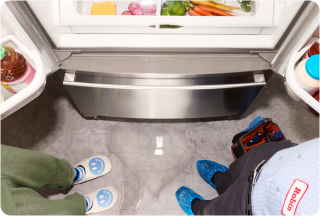Homeowner's Guide to DIY Refrigerator Maintenance

Keeping your refrigerator in top condition doesn’t have to be a chore. Learn how to tackle fridge maintenance with these easy tips from American Home Shield.


Keeping your refrigerator in top condition doesn’t have to be a chore. Learn how to tackle fridge maintenance with these easy tips from American Home Shield.
Your refrigerator does the heavy lifting in your kitchen, keeping your food fresh and your drinks cold all day, every day. But how often do you show it a little love? With a routine refrigerator maintenance checklist, you can keep it running smoothly, extend its life, and avoid those unexpected breakdowns that always seem to happen at the worst possible time.
On average, a refrigerator can last between 10 and 18 years. How long yours sticks around depends a lot on how well you maintain it. Understanding common appliance breakdowns can provide insight into potential issues; learn more in our Appliance Breakdowns by the Numbers article. If your refrigerator routine stops at restocking groceries, it might be time to reconsider your approach.
Your refrigerator is one of the few household appliances that run continuously—keeping your ice cream frosty, your veggies crips, and your leftovers just the right side of “still good.” But like any appliance, a timely checkup goes a long way in ensuring your fridge keeps its cool.
Taking a few minutes to perform some simple fridge maintenance tasks regularly will help your unit run more efficiently, saving on energy costs and expensive refrigerator repair bills and minimizing wear and tear.
Here is a refrigeration maintenance checklist that will make your fridge the coolest on the block:
The coils play a crucial role in your fridge’s cooling system, helping to release heat as the refrigerant passes through them. Over time, they collect dust, debris, and pet hair, which makes your fridge work harder and use more energy.
You can typically find the coils on the bottom or back of your fridge. If yours are in the back, you’ll need to move the refrigerator away from the wall—don’t be surprised if you discover a long-lost dog treat or a few crumbs in the process.
You can purchase a special coil-cleaning tool for the job, but a vacuum cleaner attachment or a stiff brush can also do the trick. Just run the vacuum or brush over and under the coils, removing dust as you go. Clean the condenser fan, too. Clean your coils once or twice a year, or more often if you have pets that shed. This DIY refrigerator maintenance tip can make your fridge more efficient.
Keeping your fridge and freezer at the right temperature is vital for food safety and efficiency. The fridge compartment should be between 37 and 40 degrees Fahrenheit, while the freezer should be zero degrees or lower.
If you’re unsure whether your fridge is cooling correctly, consider purchasing an inexpensive refrigerator thermometer. This small purchase can help you avoid bigger problems down the road.
The gasket—the rubber seal around your fridge door—might seem like a small player, but it’s the gatekeeper or cold air. If it’s not sealing properly, your fridge could be working harder than needed, using more energy to maintain the correct temperature as cold air seeps into the kitchen.
Regularly inspect the gasket for any signs of wear, and give it a good wipe-down with warm, soapy water to prevent crumbs and spills from harming the seal. If it’s cracked or brittle, it’s time to run to your local hardware store for a replacement.
Many people don’t realize that refrigerator ice makers and water dispensers usually have filters that need changing. Changing the filters will help keep your ice maker and water dispenser clean and running efficiently. A great way to remember to change your fridge filters is to do it when you change other filters around your home, which should be around every three months.
Check your manufacturer’s instructions for specific recommendations and replacement information for your model.
As it turns out, your mother was right: keeping the refrigerator door closed is one of the best ways to ensure proper refrigerator maintenance. Every time you open it, cold air escapes, and your fridge has to kick into overdrive to bring the temperature back down.
Deduce what you need before you open the door, and make sure the door is closed tight when you’re through. This refrigerator maintenance tip is a great way to reduce energy costs.
Learn more about warranty coverage that keeps your refrigerator running.

A wonky fridge isn’t just an eyesore—it can cause all sorts of issues, from uneven cooling to doors that don’t close right. An unlevel fridge can lead to temperature fluctuations that make it work harder and shorten its lifespan. Grab a level tool, check the shelves, and adjust the feet until everything’s squared away on all sides. Your fridge will thank you by chilling out.
Want to keep your fridge fresh and free of funky odors? It’s simple: cover your food. Uncovered food releases moisture, leading to smelly bacteria and frost buildup. Moisture and appliances don’t mix, so it’s important to control moisture whenever you can to aid in the care and maintenance of your refrigerator.
Use containers with securely fitting tops or lids, foil, or plastic wrap to keep things tidy and moisture at bay. Your fridge—and your taste buds—will appreciate it.
While you don’t want to overcrowd your refrigerator or freezer, keeping both compartments full will actually help the unit cool better and operate more efficiently. When filling your refrigerator and freezer, avoid blocking any vents or controls.
Ice, ice, baby! But seriously, rotating your ice is a simple way to keep things fresh. Old ice can get stale and absorb odors, leading to off-tasting drinks.
Periodically empty the ice container and let it refill with fresh cubes. Your next cocktail will thank you, and you’ll keep your ice maker in top form. This may not be a fridge maintenance tip, but it should definitely be added to your cleaning schedule.
A well-lit fridge is essential for spotting that last piece of cake before someone else does. If your fridge’s bulbs are burnt out or flickering, replace them ASAP. Not only does this save energy by minimizing door-open time, but it can also help you identify more significant electrical issues. And let’s face it, nobody wants to fumble around in the dark when snack time strikes.
Placing hot, steaming food directly in the fridge is like cranking up the heat in an icebox—not the best idea. Hot food raises the appliance’s internal temperature, making it harder to cool everything down.
Let your food cool to room temperature before storing it to avoid this. Dividing large batches into smaller portions can speed things up, so you can get back to chilling—literally.
The location of your refrigerator can significantly impact its efficiency. Placing your fridge next to heat sources like ovens, dishwashers, or direct sunlight can cause it to work overtime to stay cool, leading to increased energy consumption and potential wear and tear.
Ideally, your fridge would be positioned away from these heat sources, with enough space around it for proper ventilation. You don’t want cabinets or other appliances to crowd the unit too closely and impede its operation.
Even with regular refrigerator maintenance, you should be on the lookout for signs that your appliance may be on its last legs:
Catching these issues early on can save your fridge—and your wallet. Routine care and maintenance of your refrigerator is your best bet for keeping things cool and avoiding costly surprises.
Look, we get it—even the most well-cared-for fridge is bound to experience minor wear and tear over time. But with American Home Shield® in your corner, you can kiss those unexpected breakdowns goodbye for good!
Our home warranty plans covers you for parts of n up to 23 essential home systems and appliances, including your trusty refrigerator. That means no more sweating the cost of unexpected repairs, just peace of mind and more money in your pocket.
So why settle for a life of refrigerator-related stress and uncertainty? Pair your diligent fridge maintenance routine with an American Home Shield® home warranty, and enjoy the worry-free home ownership you deserve.
Don't wait—get your customized home warranty quote today and say hello to a future filled with perfectly chilled beverages, frozen treats, and the kind of refrigerator happiness that can only come from being more warranty than ever. Your fridge (and your wallet) will thank you!
AHS assumes no responsibility, and specifically disclaims all liability, for your use of any and all information contained herein.
Have a plan for your home when things don't go according to plan
Shop Home WarrantiesDevelopment